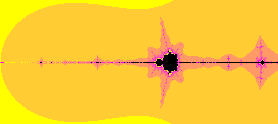| The small copies of the Mandelbrot set sometimes are called midgets. |
| Some years ago, Adam Robucci, a student of mine, wanted to generate pictures of
ultra-small midgets. When Adam started his project, the smallest well-known midget was
Richard Voss' Avogadro's Midget, magnified by a factor of 1023.
Click here to see Avogadro's midget, in a
new window. Adam wanted to find one smaller. |
| We devised a method to find the
midgets along the real axis, the horizontal line bisecting the Mandelbrot set. |
| For higher n there are many n-cycle midgets, so Adam located |
| the left-most 3-cycle midget (there is only one 3-cycle midget), |
| the left-most 4-cycle midget (there is only one 4-cycle midget on the real axis), |
| the left-most 5-cycle midget (there are three 5-cycle midgets on the real axis), |
| and so on. |
|
| Eventually he produced a picture of a midget magnified by a factor
of 10359, but had grown bored with that project.
Click here to see this midget, and an estimate of how
very small it is. |
| I suggested he compute a Feigenbaum ratio
called the Robucci constant. |
| The sequence of ratios does have a limit, but it
will never be called the Robucc constant: the limit is 4, exactly 4. |
| The numerical discovery is reported in Philip, Robucci, Frame,
the proof in Hurwitz, Frame, Peak, and is
outlined below. |
|

